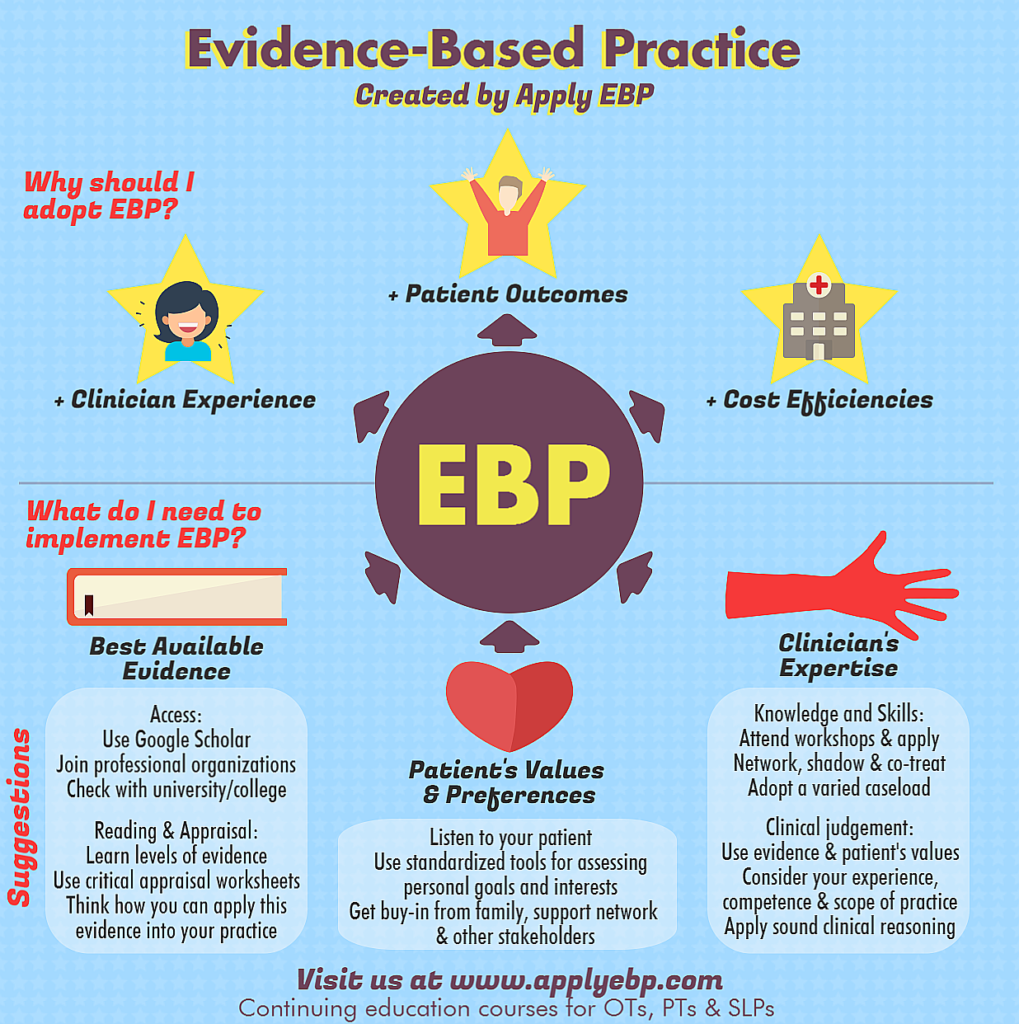Apply EBP loves evidence-based practice (EBP) so much that we took its initials to become our last name. What is evidence-based practice (EBP)? And how come every time somebody tries to explain it to me, it puts me to sleep?
There are longer explanations out there, available from different resources. What I’ll try to do here is to give you a short, easy-to-digest info about EBP, with the hope of getting you excited about EBP. Then, there is a caveat! You will use this initial knowledge and excitement to read other resources cited below to gain more in-depth knowledge and strategies for applying EBP.
Why Should I Adopt EBP?
Clinically, the goal of EBP is to deliver the best possible outcome for each and every patient through the application of the 3 components listed below. This means better assessment, goal setting, treatment planning, service provision and progress monitoring of our patients.
And it works! As examples, you can click here to see 15 different outcomes that have been achieved from various healthcare fields.
With emerging evidence, adopting EBP has also been shown to create cost efficiencies for organizations and positive experiences for clinicians. Wouldn’t you feel great and fulfilled if you are helping create positive health and quality of life outcomes for your patients? Adopting EBP is a win-win-win!

What Do I Need to Implement EBP?
EBP requires that 3 components are integrated: best available evidence, patient values & preferences, and clinical expertise.
Best Available Evidence
We need to find and understand the latest research that are relevant to our patient. To access research, use Google Scholar, join professional organizations (e.g., APTA, AOTA, ASHA), or check with your college or university.
Some research studies are better than others.
When available, meta-analysis and systematic reviews are best since they synthesize different studies into 1 report. You may also find clinical practice guidelines based on systematic reviews.
Otherwise, try to find randomized controlled trials (RCTs), where subjects are randomized into groups of different interventions.
Know the limitations of non-randomized controlled trial studies and surveys. They may show associations between 2 or more variables, but not cause-and-effect.
Case studies are not generalizable, but they may provide a more detailed description of how to apply certain strategies.
Treat expert opinions as opinions that engages you to think; or use them to direct you to studies they cite. They may even point you to meta-analyses or systematic reviews.
For more information, read and learn the levels of evidence.
You need to critically appraise the research you have found for factors such as credibility and applicability to your patient. For this you can use worksheets cited in the readings and tools below.
Patient’s Values and Preferences
My favorite part of the EBP triad is patient’s values & preferences. Ask and understand what the patient wants and needs. The patient’s interest and motivation is key to their success. Even proven interventions can fail, if patients are not interested in the outcomes or the intervention itself. Note that in pediatrics, this also often means getting the buy-in of the whole family and other support network (teachers, agencies, etc.).
Learn to use standardized assessment tools designed to explore patient’s preferences and goal setting, such as the Perceived Efficacy and Goal Setting System -II (PEGS-II), The Canadian Occupational Performance Measure (COPM) and the Preferences for Activities of Children (PAC).
Clinical Expertise
To complete the triad, your clinical expertise is needed! Now that you know the best available evidence and what the patient values, use your competence, scope of practice, clinical reasoning and decision-making to provide the best possible care and reach the outcomes the patient prefers.
To improve your own knowledge and skills, it is important to enrich yourself through additional means, such as workshops, adopting a varied caseload (unless you want to become an expert in a specific field), and a network of colleagues to co-treat, learn and bounce of ideas with.
How Does Apply EBP Help You with EBP?
At the risk of being redundant, Apply EBP is here to help you apply EBP! Our team of expert presenters search, assess and translate relevant evidence into real-life practice. Strategies to integrate patient’s values and preferences into the treatment planning and intervention are highlighted in every course. Clinician’s expertise is enhanced via discussions, clinical reasoning activities, laboratory components, and provision of practical toolkits that can be utilized at work the very next day.
Ready to Apply EBP? Check out our upcoming courses.
Readings & Tools:
Duke University’s Introduction to Evidence-based Practice
Knowledge Translation Program’s Critical Appraisal Worksheets
UNC’s Five Steps of EBP

Thank you I am a instructor teaching EBP in nursing I want the latest materials to be able to enhance my students future.